Xu Cheng
CETC Big Data Research Institute
LIDAR: Lightweight Adaptive Cue-Aware Fusion Vision Mamba for Multimodal Segmentation of Structural Cracks
Jul 30, 2025Abstract:Achieving pixel-level segmentation with low computational cost using multimodal data remains a key challenge in crack segmentation tasks. Existing methods lack the capability for adaptive perception and efficient interactive fusion of cross-modal features. To address these challenges, we propose a Lightweight Adaptive Cue-Aware Vision Mamba network (LIDAR), which efficiently perceives and integrates morphological and textural cues from different modalities under multimodal crack scenarios, generating clear pixel-level crack segmentation maps. Specifically, LIDAR is composed of a Lightweight Adaptive Cue-Aware Visual State Space module (LacaVSS) and a Lightweight Dual Domain Dynamic Collaborative Fusion module (LD3CF). LacaVSS adaptively models crack cues through the proposed mask-guided Efficient Dynamic Guided Scanning Strategy (EDG-SS), while LD3CF leverages an Adaptive Frequency Domain Perceptron (AFDP) and a dual-pooling fusion strategy to effectively capture spatial and frequency-domain cues across modalities. Moreover, we design a Lightweight Dynamically Modulated Multi-Kernel convolution (LDMK) to perceive complex morphological structures with minimal computational overhead, replacing most convolutional operations in LIDAR. Experiments on three datasets demonstrate that our method outperforms other state-of-the-art (SOTA) methods. On the light-field depth dataset, our method achieves 0.8204 in F1 and 0.8465 in mIoU with only 5.35M parameters. Code and datasets are available at https://github.com/Karl1109/LIDAR-Mamba.
Dynamic Graph-Like Learning with Contrastive Clustering on Temporally-Factored Ship Motion Data for Imbalanced Sea State Estimation in Autonomous Vessel
Apr 21, 2025



Abstract:Accurate sea state estimation is crucial for the real-time control and future state prediction of autonomous vessels. However, traditional methods struggle with challenges such as data imbalance and feature redundancy in ship motion data, limiting their effectiveness. To address these challenges, we propose the Temporal-Graph Contrastive Clustering Sea State Estimator (TGC-SSE), a novel deep learning model that combines three key components: a time dimension factorization module to reduce data redundancy, a dynamic graph-like learning module to capture complex variable interactions, and a contrastive clustering loss function to effectively manage class imbalance. Our experiments demonstrate that TGC-SSE significantly outperforms existing methods across 14 public datasets, achieving the highest accuracy in 9 datasets, with a 20.79% improvement over EDI. Furthermore, in the field of sea state estimation, TGC-SSE surpasses five benchmark methods and seven deep learning models. Ablation studies confirm the effectiveness of each module, demonstrating their respective roles in enhancing overall model performance. Overall, TGC-SSE not only improves the accuracy of sea state estimation but also exhibits strong generalization capabilities, providing reliable support for autonomous vessel operations.
From Laboratory to Real World: A New Benchmark Towards Privacy-Preserved Visible-Infrared Person Re-Identification
Mar 15, 2025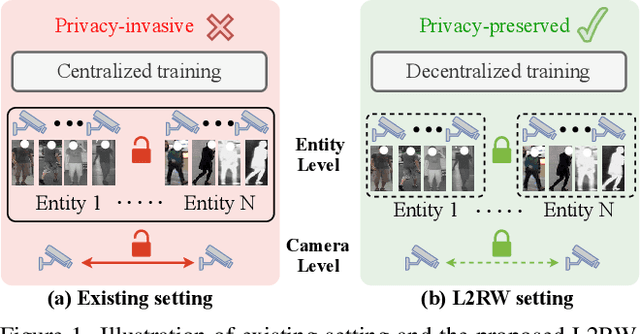
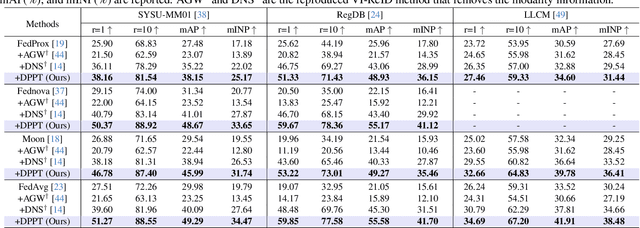
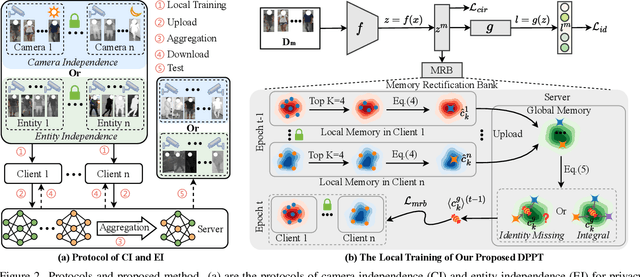

Abstract:Aiming to match pedestrian images captured under varying lighting conditions, visible-infrared person re-identification (VI-ReID) has drawn intensive research attention and achieved promising results. However, in real-world surveillance contexts, data is distributed across multiple devices/entities, raising privacy and ownership concerns that make existing centralized training impractical for VI-ReID. To tackle these challenges, we propose L2RW, a benchmark that brings VI-ReID closer to real-world applications. The rationale of L2RW is that integrating decentralized training into VI-ReID can address privacy concerns in scenarios with limited data-sharing regulation. Specifically, we design protocols and corresponding algorithms for different privacy sensitivity levels. In our new benchmark, we ensure the model training is done in the conditions that: 1) data from each camera remains completely isolated, or 2) different data entities (e.g., data controllers of a certain region) can selectively share the data. In this way, we simulate scenarios with strict privacy constraints which is closer to real-world conditions. Intensive experiments with various server-side federated algorithms are conducted, showing the feasibility of decentralized VI-ReID training. Notably, when evaluated in unseen domains (i.e., new data entities), our L2RW, trained with isolated data (privacy-preserved), achieves performance comparable to SOTAs trained with shared data (privacy-unrestricted). We hope this work offers a novel research entry for deploying VI-ReID that fits real-world scenarios and can benefit the community.
Prototype-based Heterogeneous Federated Learning for Blade Icing Detection in Wind Turbines with Class Imbalanced Data
Mar 11, 2025Abstract:Wind farms, typically in high-latitude regions, face a high risk of blade icing. Traditional centralized training methods raise serious privacy concerns. To enhance data privacy in detecting wind turbine blade icing, traditional federated learning (FL) is employed. However, data heterogeneity, resulting from collections across wind farms in varying environmental conditions, impacts the model's optimization capabilities. Moreover, imbalances in wind turbine data lead to models that tend to favor recognizing majority classes, thus neglecting critical icing anomalies. To tackle these challenges, we propose a federated prototype learning model for class-imbalanced data in heterogeneous environments to detect wind turbine blade icing. We also propose a contrastive supervised loss function to address the class imbalance problem. Experiments on real data from 20 turbines across two wind farms show our method outperforms five FL models and five class imbalance methods, with an average improvement of 19.64\% in \( mF_{\beta} \) and 5.73\% in \( m \)BA compared to the second-best method, BiFL.
SCSegamba: Lightweight Structure-Aware Vision Mamba for Crack Segmentation in Structures
Mar 03, 2025Abstract:Pixel-level segmentation of structural cracks across various scenarios remains a considerable challenge. Current methods encounter challenges in effectively modeling crack morphology and texture, facing challenges in balancing segmentation quality with low computational resource usage. To overcome these limitations, we propose a lightweight Structure-Aware Vision Mamba Network (SCSegamba), capable of generating high-quality pixel-level segmentation maps by leveraging both the morphological information and texture cues of crack pixels with minimal computational cost. Specifically, we developed a Structure-Aware Visual State Space module (SAVSS), which incorporates a lightweight Gated Bottleneck Convolution (GBC) and a Structure-Aware Scanning Strategy (SASS). The key insight of GBC lies in its effectiveness in modeling the morphological information of cracks, while the SASS enhances the perception of crack topology and texture by strengthening the continuity of semantic information between crack pixels. Experiments on crack benchmark datasets demonstrate that our method outperforms other state-of-the-art (SOTA) methods, achieving the highest performance with only 2.8M parameters. On the multi-scenario dataset, our method reached 0.8390 in F1 score and 0.8479 in mIoU. The code is available at https://github.com/Karl1109/SCSegamba.
Can Students Beyond The Teacher? Distilling Knowledge from Teacher's Bias
Dec 13, 2024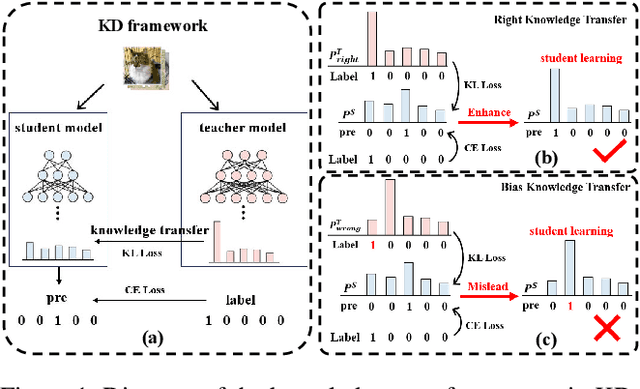
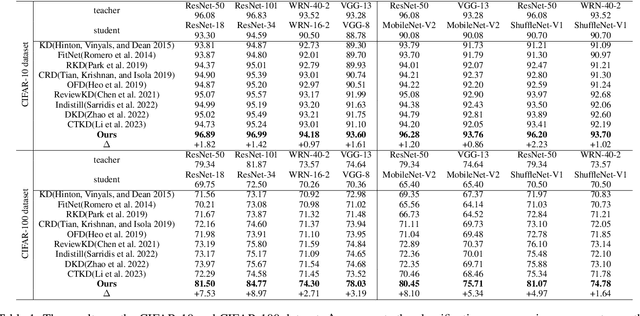
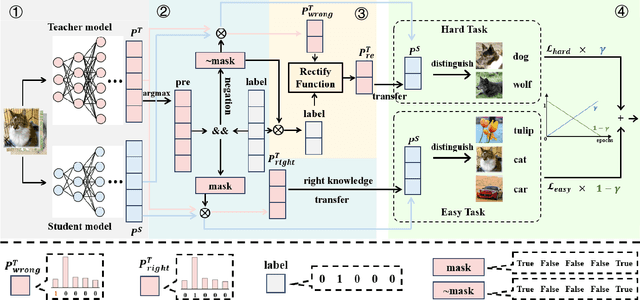
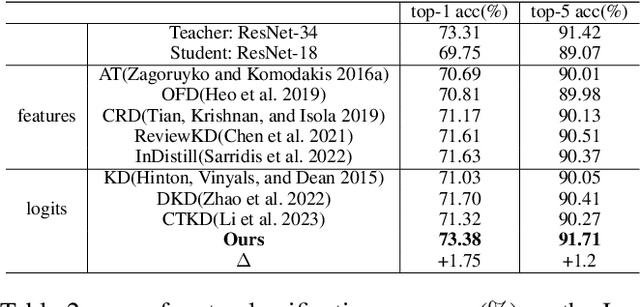
Abstract:Knowledge distillation (KD) is a model compression technique that transfers knowledge from a large teacher model to a smaller student model to enhance its performance. Existing methods often assume that the student model is inherently inferior to the teacher model. However, we identify that the fundamental issue affecting student performance is the bias transferred by the teacher. Current KD frameworks transmit both right and wrong knowledge, introducing bias that misleads the student model. To address this issue, we propose a novel strategy to rectify bias and greatly improve the student model's performance. Our strategy involves three steps: First, we differentiate knowledge and design a bias elimination method to filter out biases, retaining only the right knowledge for the student model to learn. Next, we propose a bias rectification method to rectify the teacher model's wrong predictions, fundamentally addressing bias interference. The student model learns from both the right knowledge and the rectified biases, greatly improving its prediction accuracy. Additionally, we introduce a dynamic learning approach with a loss function that updates weights dynamically, allowing the student model to quickly learn right knowledge-based easy tasks initially and tackle hard tasks corresponding to biases later, greatly enhancing the student model's learning efficiency. To the best of our knowledge, this is the first strategy enabling the student model to surpass the teacher model. Experiments demonstrate that our strategy, as a plug-and-play module, is versatile across various mainstream KD frameworks. We will release our code after the paper is accepted.
Why pre-training is beneficial for downstream classification tasks?
Oct 11, 2024



Abstract:Pre-training has exhibited notable benefits to downstream tasks by boosting accuracy and speeding up convergence, but the exact reasons for these benefits still remain unclear. To this end, we propose to quantitatively and explicitly explain effects of pre-training on the downstream task from a novel game-theoretic view, which also sheds new light into the learning behavior of deep neural networks (DNNs). Specifically, we extract and quantify the knowledge encoded by the pre-trained model, and further track the changes of such knowledge during the fine-tuning process. Interestingly, we discover that only a small amount of pre-trained model's knowledge is preserved for the inference of downstream tasks. However, such preserved knowledge is very challenging for a model training from scratch to learn. Thus, with the help of this exclusively learned and useful knowledge, the model fine-tuned from pre-training usually achieves better performance than the model training from scratch. Besides, we discover that pre-training can guide the fine-tuned model to learn target knowledge for the downstream task more directly and quickly, which accounts for the faster convergence of the fine-tuned model.
Layerwise Change of Knowledge in Neural Networks
Sep 13, 2024



Abstract:This paper aims to explain how a deep neural network (DNN) gradually extracts new knowledge and forgets noisy features through layers in forward propagation. Up to now, although the definition of knowledge encoded by the DNN has not reached a consensus, Previous studies have derived a series of mathematical evidence to take interactions as symbolic primitive inference patterns encoded by a DNN. We extend the definition of interactions and, for the first time, extract interactions encoded by intermediate layers. We quantify and track the newly emerged interactions and the forgotten interactions in each layer during the forward propagation, which shed new light on the learning behavior of DNNs. The layer-wise change of interactions also reveals the change of the generalization capacity and instability of feature representations of a DNN.
Staircase Cascaded Fusion of Lightweight Local Pattern Recognition and Long-Range Dependencies for Structural Crack Segmentation
Aug 23, 2024



Abstract:Detecting cracks with pixel-level precision for key structures is a significant challenge, as existing methods struggle to effectively integrate local textures and pixel dependencies of cracks. Furthermore, these methods often possess numerous parameters and substantial computational requirements, complicating deployment on edge devices. In this paper, we propose a staircase cascaded fusion crack segmentation network (CrackSCF) that generates high-quality crack segmentation maps using minimal computational resources. We constructed a staircase cascaded fusion module that effectively captures local patterns of cracks and long-range dependencies of pixels, and it can suppress background noise well. To reduce the computational resources required by the model, we introduced a lightweight convolution block, which replaces all convolution operations in the network, significantly reducing the required computation and parameters without affecting the network's performance. To evaluate our method, we created a challenging benchmark dataset called TUT and conducted experiments on this dataset and five other public datasets. The experimental results indicate that our method offers significant advantages over existing methods, especially in handling background noise interference and detailed crack segmentation. The F1 and mIoU scores on the TUT dataset are 0.8382 and 0.8473, respectively, achieving state-of-the-art (SOTA) performance while requiring the least computational resources. The code and dataset is available at https://github.com/Karl1109/CrackSCF.
An End-to-End Model for Time Series Classification In the Presence of Missing Values
Aug 11, 2024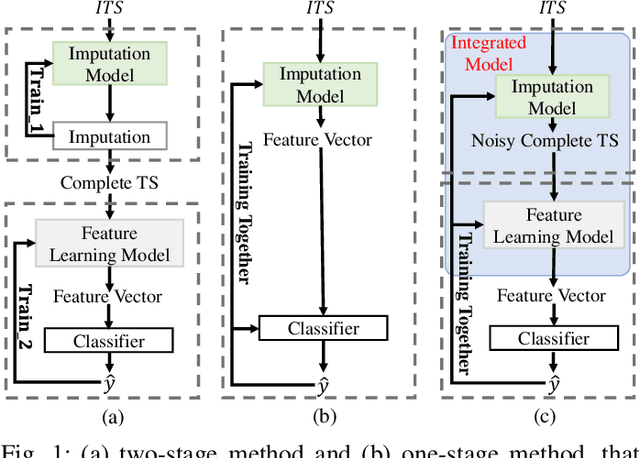
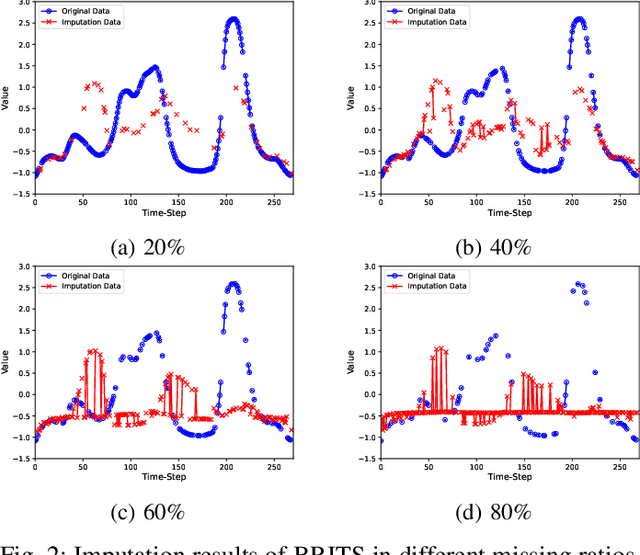
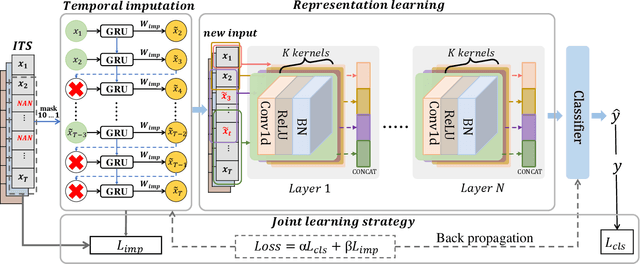
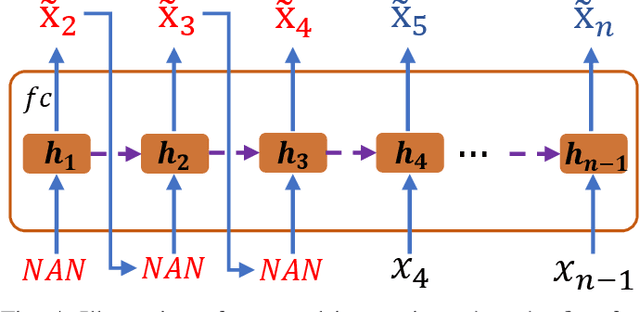
Abstract:Time series classification with missing data is a prevalent issue in time series analysis, as temporal data often contain missing values in practical applications. The traditional two-stage approach, which handles imputation and classification separately, can result in sub-optimal performance as label information is not utilized in the imputation process. On the other hand, a one-stage approach can learn features under missing information, but feature representation is limited as imputed errors are propagated in the classification process. To overcome these challenges, this study proposes an end-to-end neural network that unifies data imputation and representation learning within a single framework, allowing the imputation process to take advantage of label information. Differing from previous methods, our approach places less emphasis on the accuracy of imputation data and instead prioritizes classification performance. A specifically designed multi-scale feature learning module is implemented to extract useful information from the noise-imputation data. The proposed model is evaluated on 68 univariate time series datasets from the UCR archive, as well as a multivariate time series dataset with various missing data ratios and 4 real-world datasets with missing information. The results indicate that the proposed model outperforms state-of-the-art approaches for incomplete time series classification, particularly in scenarios with high levels of missing data.
 Add to Chrome
Add to Chrome Add to Firefox
Add to Firefox Add to Edge
Add to Edge